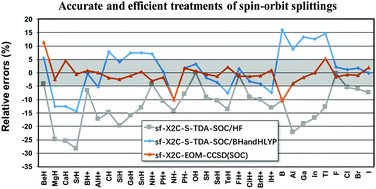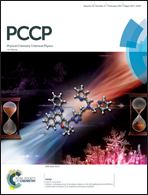Combining the spin-separated exact two-component relativistic Hamiltonian with the equation-of-motion coupled-cluster method for the treatment of spin–orbit splittings of light and heavy elements
Abstract
The spin-separated exact two-component (X2C) relativistic Hamiltonian [sf-X2C+so-DKHn, J. Chem. Phys., 2012, 137, 154114] is combined with the equation-of-motion coupled-cluster method with singles and doubles (EOM-CCSD) for the treatment of spin–orbit splittings of open-shell molecular systems. Scalar relativistic effects are treated to infinite order from the outset via the spin-free part of the X2C Hamiltonian (sf-X2C), whereas the spin–orbit couplings (SOC) are handled at the CC level via the first-order Douglas–Kroll–Hess (DKH) type of spin–orbit operator (so-DKH1). Since the exponential of single excitations, i.e., exp(T1), introduces sufficient spin orbital relaxations, the inclusion of SOC at the CC level is essentially the same in accuracy as the inclusion of SOC from the outset in terms of the two-component spinors determined variationally by the sf-X2C+so-DKH1 Hamiltonian, but is computationally more efficient. Therefore, such an approach (denoted as sf-X2C-EOM-CCSD(SOC)) can achieve uniform accuracy for the spin–orbit splittings of both light and heavy elements. For light elements, the treatment of SOC can even be postponed until the EOM step (denoted as sf-X2C-EOM(SOC)-CCSD), so as to further reduce the computational cost. To reveal the efficacy of sf-X2C-EOM-CCSD(SOC) and sf-X2C-EOM(SOC)-CCSD, the spin–orbit splittings of the 2Π states of monohydrides up to the sixth row of the periodic table are investigated. The results show that sf-X2C-EOM-CCSD(SOC) predicts very accurate results (within 5%) for elements up to the fifth row, whereas sf-X2C-EOM(SOC)-CCSD is useful only for light elements (up to the third row but with some exceptions). For comparison, the sf-X2C-S-TD-DFT-SOC approach [spin-adapted open-shell time-dependent density functional theory, Mol. Phys., 2013, 111, 3741] is applied to the same systems. The overall accuracy (1–10%) is satisfactory.



 Please wait while we load your content...
Please wait while we load your content...